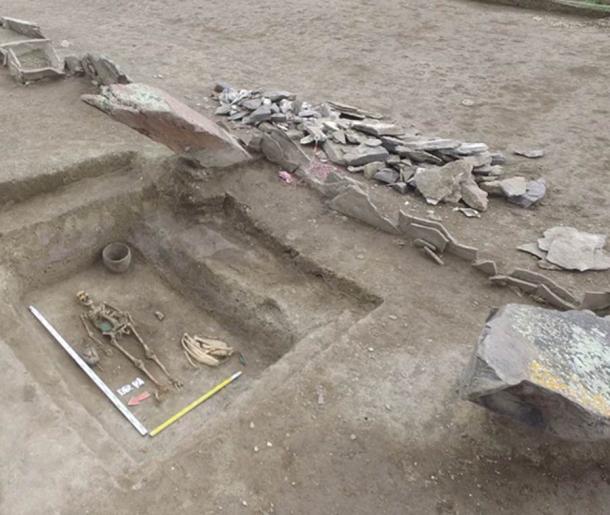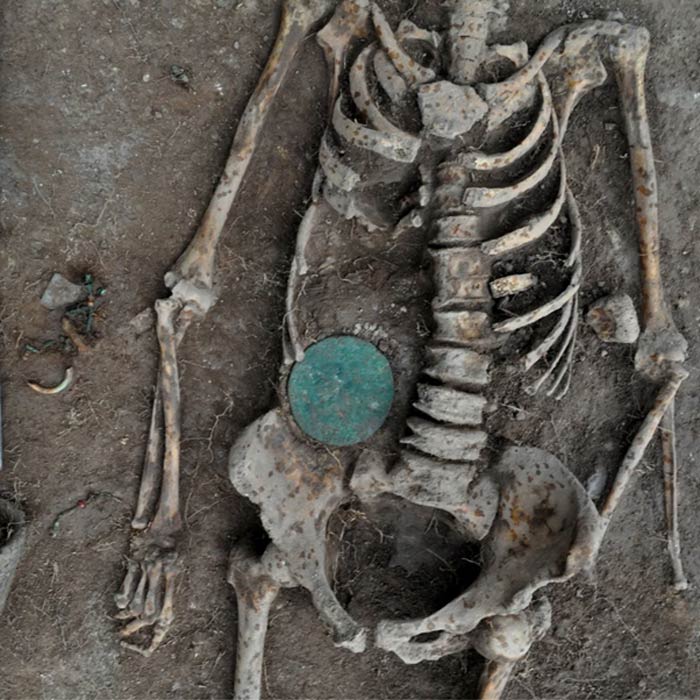
Bronze Age Human Bone Amulet Found in Ancient Siberian Tagar Burial
How a culture buries its dead provides a crucial understanding of a culture across time periods, across historical divides, across geographical territories. Some of these ancient and prehistoric practices have been retained by modern humans, reflected in many modern cultures and religions with cremation and burials being important examples. Recently, an extraordinary Bronze Age grave bone amulet made with one human bone piece, an anomaly, has been found in a southern Siberia grave, reports Haaretz.

The female Tagar culture grave, where the “human” bone amulet was found next to her on the left side of this image, just above the ceramic vessel. (Evgeniy Bogdanov / Haaretz)
The Tagar Culture Grave and Human Bone Amulet
The fertile Siberian Minusinsk basin has been home to a multitude of historical cultures, most famously the Tagars of the Siberian steppe. In 2020, the cemetery known as Kazanovka 1 (Late Bronze Age to the early Iron Age) was excavated. The Tagars were a Bronze Age culture that flourished between the 8th century and 2nd century BC in southern Siberia, sandwiched between the Karasuk and the Tashtyk cultures respectively. It is widely recognized as one of the largest centers of bronze smelting in ancient Eurasia, contemporaneous with the Scythians in the Crimea and the north Black Sea region.
- Mystery of 2,100-year-old Death Mask Found to Contain Ram’s Skull
- Reconstructing Brain Surgery as It Was Conducted Around 3,000 Years Ago
Several hundred Tagar burial mounds have been preserved and recorded. And from these mounds thousands of exquisitely preserved bronze items have been excavated and put on display at the Khakass National Museum in Abakan. Yet, such a find from the early Tagar culture period has never been found before in the graves of Kurgan burial mound No. 15.
In mound #15, which had two enclosures, the main enclosure contained four graves with three adults in the middle of the mound. The mourners had dug a 2.5 x 4.45 meters (8.2 x 14.5 feet) pit, with a border around the perimeter that was adorned with small flagstones, and a horse skull laid on the grave’s cover. Here was the object of curiosity and wonder, laid with a woman who had been placed on her back with her face to the west.
She had been buried with pottery vessels, a bronze mirror, a leather case, bronze plaques and pins, chunks of meat and carcasses of a calf and sheep (a continuation of Karashuk traditions), and a bronze amulet placed next to her right elbow. In the center, the amulet contained the fragment of a human bone and a silken cloth bag (now in shreds), while the upper side comprised threaded tubular bronze and carnelian beads, and the lower part had a hanging boar fang!
Incidentally, other burials from the region have reported beads, animal bones, fangs of boars or musk deer, and bird claws, so this is clearly not uncommon. Such amulets have also been found in the basin, and almost always exclusively in conjunction with female burials.
The human bone is an anomaly, and the archaeologists suspect that it had some sort of magical or ritual purpose. This could also be an example of a secondary burial, i.e., post burial manipulation of remains and grave goods within the culture which could have caused the amulet to be placed next to her later.

The bone amulet next to the woman’s right side (left side of image) of which one piece is a human bone fragment, making this grave and unique anomaly among all other early Tagar culture graves. (Evgeniy Bogdanov / Haaretz)
Global Burial Practices and Problems with Tagar Documentation
While mummification is a way of carefully preserving the dead as they descend into the afterlife, cremations are a way of burning the mortal remains into ashes (ashes hold a spiritual and religious significance in many cultures). Mummification dates to at least 8,000 years ago, as reported by Ancient Origins earlier this month, while cremation dates back to at least 17,000 years ago. Secondary burials are those wherein the remains of the dead are manipulated, and they are commonly associated with prehistoric Western Asian cultures.
The deceased are generally accompanied by grave goods for a smooth ascent into the afterlife and having valuable material possessions “allowed for” an elevated entry into the world that comes after this one. These votive deposits are also a way of marking the social status of the deceased in the current life and, for archaeologists and historians, have proved to be a marker of understanding the burial practices of our ancestors. The earliest undisputed grave good burials date to the Upper Paleolithic, roughly between 40,000 and 12,000 years ago!
All these aforementioned practices are packed with rituals and ceremonies that vary widely across the world’s religions. Today, it is common for an intermediary or a priest to conduct this ceremony in the presence of family and loved ones. In ancient Egypt, manuals were written to preserve the ceremonial details of these events for those in the future, who would follow the same steps when their time came.
- Ancient Siberians Bred, Bought and Traded Arctic Dogs
- Unique Golden Pectoral Ornament Found in 2,500-Year-Old Scythian Grave
While it is one of the most widely studied ancient Siberian cultures, the ethnographic burial practices of the Tagars virtually remain unknown, mainly due to grave looting, which poses an immense threat to archaeological reconstruction.
The Russian Siberian Minusinsk basin is not good for the preservation of post depositional organic and other materials, making it harder for historical reconstructions. Finally, the early phases of grave explorations have been marked by shoddy analysis and documentation, resulting in the loss of invaluable artifacts and documentation.
Top image: A closeup of the Tagar female grave (excavated in the Siberian steppe Minusinsk basin), which is an anomaly because the bone amulet next to her wrist is made with one piece of human bone, suggesting secondary burial grave manipulation. Source: Evgeniy Bogdanov / Haaretz
By Sahir Pandey
References
Rich, V.G. 2022. Archaeologists Find Amulet Made of Human Bone in Siberia. Available at: https://www.haaretz.com/archaeology/MAGAZINE-archaeologists-find-amulet-made-of-human-bone-in-siberia-1.10671553.















